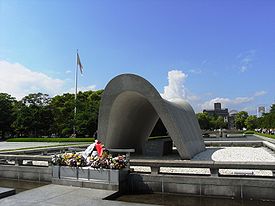Hiroshima Peace Memorial Park
| Hiroshima Peace Memorial Park | |
|---|---|

Hiroshima Peace Memorial Park
|
|
| Type | Public Park for World Peace |
| Location | Hiroshima |
| Coordinates | 34°23′34″N 132°27′09″E / 34.392728°N 132.452374°ECoordinates: 34°23′34″N 132°27′09″E / 34.392728°N 132.452374°E |
| Created | April 1, 1954 |
| Status | Open all year |
| Website | Hiroshima Peace Memorial Park |
Hiroshima Peace Memorial Park (広島平和記念公園 Hiroshima Heiwa Kinen Kōen?) is a memorial park in the center of Hiroshima, Japan. It is dedicated to the legacy of Hiroshima as the first city in the world to suffer a nuclear attack, and to the memories of the bomb's direct and indirect victims (of whom there may have been as many as 140,000). The Hiroshima Peace Memorial Park was planned and designed by the Japanese Architect Kenzō Tange at Tange Lab.
The location of Hiroshima Peace Memorial Park was once the city’s busiest downtown commercial and residential district. The park was built on an open field that was created by the explosion. Today there are a number of memorials and monuments, museums, and lecture halls, which draw over a million visitors annually. The annual 6 August Peace Memorial Ceremony, which is sponsored by the city of Hiroshima, is also held in the park. The purpose of the Peace Memorial Park is to not only memorialize the victims, but also to establish the memory of nuclear horrors and advocate world peace.
The A-Bomb Dome is the skeletal ruins of the former Hiroshima Prefectural Industrial Promotion Hall. It is the building closest to the hypocenter of the nuclear bomb that remained at least partially standing. It was left how it was after the bombing in memory of the casualties. The A-Bomb Dome, to which a sense of sacredness and transcendence has been attributed, is situated in a distant ceremonial view that is visible from the Peace Memorial Park’s central cenotaph. It is an officially designated site of memory for the nation’s and humanity’s collectively shared heritage of catastrophe. The A-Bomb Dome was added to the UNESCO World Heritage List on December 7, 1996. Many A-Bomb survivors and Hiroshima citizens were pushing for the A-Bomb Dome to be registered as a World Heritage Site as it was "a symbol of horror and nuclear weapons and humankind's pledge for peace." This collective petition from many citizens groups was finally given influence when the Japanese government officially recommended the dome to the World Heritage Site committee in December 1995. A marker was placed on the A-Bomb Dome on April 25, 1997 by Hiroshima City. It reads:
...
Wikipedia
